INterpolated FLOod Surface (INFLOS), a Rapid and Operational Tool to Estimate Flood Depths from Earth Observation Data for Emergency Management
Abstract
1. Introduction
1.1. Context
1.2. State of the Art
2. Materials and Methods
- (A)
- Flood depth, referred to as , can be determined by initially estimating a flood surface, denoted as . This is achieved by subtracting elevation data e from the flood surface. Consequently, . Negative values of correspond to areas unaffected by the flood and located outside the boundaries of the observed event layer.
- (B)
- Flood depth at the edges of flooded areas can be approximated as zero, as described by the formula for edge vertices.
- (C)
- Considering the large analysis scales of CEMS RM, cross-sections of a flooded area should approximate a flat water surface, with slopes of a dozen centimetres per kilometre at most [32]. Indeed, INFLOS does not take local hydrodynamic processes into account, but rather focusses on the effects of gravity on water. As a result, processes such as water surface bulging in the concave bank of a meandering river are not accounted for [33].
- (D)
- It is not possible to consistently infer the bathymetry of hydrological features or the corresponding water depth from the various DTM specifications made available during flood activations.
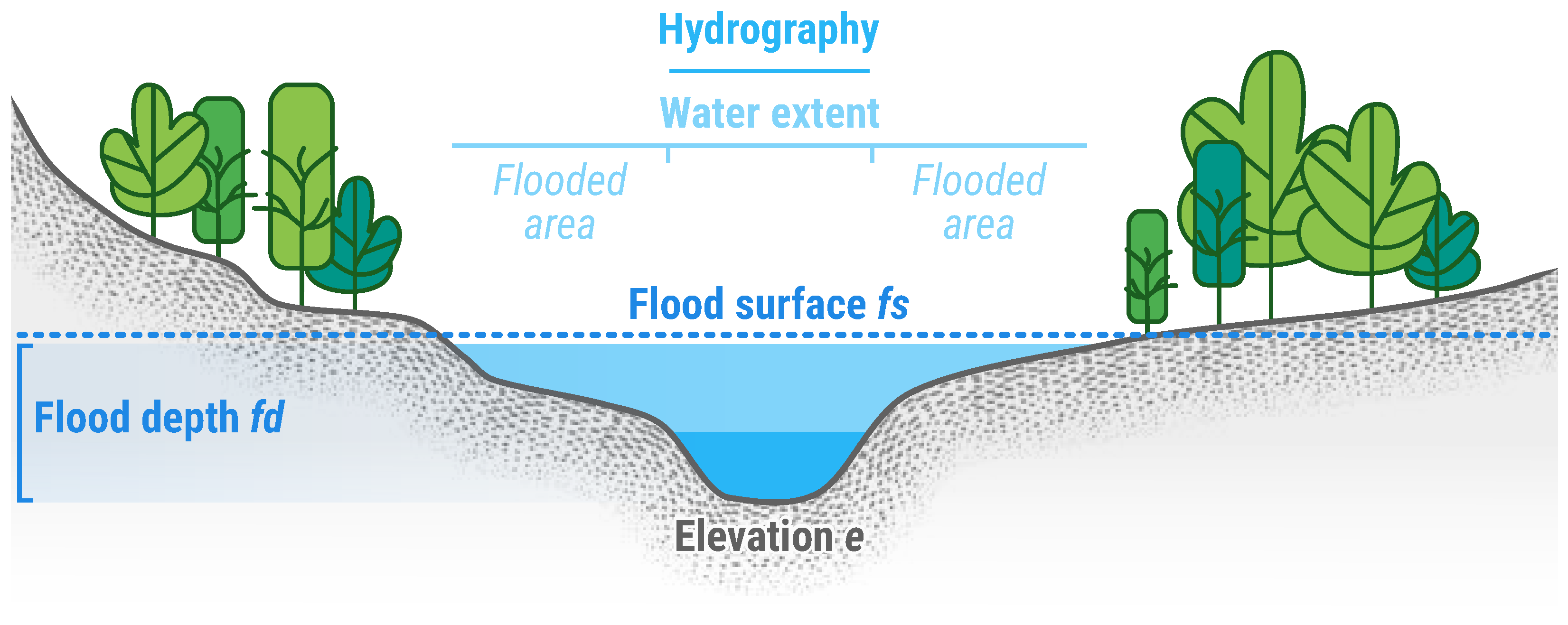
2.1. Preparation of Sample Points
2.2. First-Pass Interpolation
- Exact spatial interpolation is mandatory to ensure border samples have a flood depth of 0, satisfying assumption (B), which states .
- Given the time constraints of CEMS RM, the interpolation technique must produce results as fast as possible.
- The interpolation method should operate without requiring fine-tuning of parameters, as it requires expertise and time to test multiple configurations. Preferably, only sample locations and heights should be needed as input. Indeed, an important objective of this development for rapid mapping is that the operator does not intervene.
- is the interpolated value at point x.
- are the values of neighbouring data points.
- N is the number of neighbouring data points contributing to the interpolation.
- is the weight assigned to a neighbour i.
- is the area of the overlap between the Voronoi polygon of neighbour i and that of the interpolated point.
- is the total area of the Voronoi polygon for the interpolated point.
2.3. Sample Refinement and Densification
2.4. Second-Pass Interpolation and Flood Depth Computation
2.5. Validation and Quality Assessment
- n is the sample size.
- Z is the critical value of the standard normal distribution for a given confidence level. In this case, it ensures that the sample size is sufficient to verify that reference and interpolated elevations are not significantly different from one another. With the desired confidence interval of , the critical value is equal to .
- is the standard deviation of differences between reference and interpolated elevations, estimated from a pilot dataset.
- e is the acceptable margin of error, set to be within m of the mean reference elevation.
- is the adjusted sample size.
- n is the sample size, calculated using Formula (4).
- N is the total population size, corresponding to the total number of vertices for a given flood product.
3. Implementing the Algorithm and Results
3.1. Development Stage Overview
3.2. Proof of Concept
3.3. Pre-Operational Environment
3.4. Benchmarking
3.5. Operational Production
4. Discussion
5. Conclusions
Author Contributions
Funding
Data Availability Statement
Acknowledgments
Conflicts of Interest
References
- Tarasova, L.; Lun, D.; Merz, R.; Blöschl, G.; Basso, S.; Bertola, M.; Miniussi, A.; Rakovec, O.; Samaniego, L.; Thober, S.; et al. Shifts in flood generation processes exacerbate regional flood anomalies in Europe. Commun. Earth Environ. 2023, 4, 49. [Google Scholar] [CrossRef] [PubMed]
- Delforge, D.; Wathelet, V.; Below, R.; Sofia, C.L.; Tonnelier, M.; Loenhout, J.v.; Speybroeck, N. EM-DAT: The Emergency Events Database. Res. Sq. 2024; preprint. [Google Scholar] [CrossRef]
- Blöschl, G.; Hall, J.; Viglione, A.; Perdigão, R.A.P.; Parajka, J.; Merz, B.; Lun, D.; Arheimer, B.; Aronica, G.T.; Bilibashi, A.; et al. Changing climate both increases and decreases European river floods. Nature 2019, 573, 108–111. [Google Scholar] [CrossRef] [PubMed]
- Rentschler, J.; Salhab, M. People in Harm’s Way: Flood Exposure and Poverty in 189 Countries; Technical Report; World Bank: Washington, DC, USA, 2020. [Google Scholar] [CrossRef]
- Makhnovsky, D. The Coastal Regions of Europe: Economic Development at the Turn of the 20th Century. Balt. Reg. 2014, 4, 50–66. [Google Scholar] [CrossRef]
- European Commission; Eurostat. Eurostat Regional Yearbook 2011; Publications Office: Luxembourg, 2011. [Google Scholar]
- Kummu, M.; De Moel, H.; Ward, P.J.; Varis, O. How Close Do We Live to Water? A Global Analysis of Population Distance to Freshwater Bodies. PLoS ONE 2011, 6, e20578. [Google Scholar] [CrossRef] [PubMed]
- United Nations. World Urbanization Prospects: The 2018 Revision; United Nations: New York, NY, USA, 2019; OCLC: 1120698127. [Google Scholar]
- Notti, D.; Giordan, D.; Caló, F.; Pepe, A.; Zucca, F.; Galve, J.P. Potential and Limitations of Open Satellite Data for Flood Mapping. Remote Sens. 2018, 10, 1673. [Google Scholar] [CrossRef]
- Boccardo, P.; Giulio Tonolo, F. Remote Sensing Role in Emergency Mapping for Disaster Response. In Engineering Geology for Society and Territory—Volume 5; Lollino, G., Manconi, A., Guzzetti, F., Culshaw, M., Bobrowsky, P., Luino, F., Eds.; Springer International Publishing: Cham, Switzerland, 2015; pp. 17–24. [Google Scholar] [CrossRef]
- Munawar, H.S.; Hammad, A.W.A.; Waller, S.T. Remote Sensing Methods for Flood Prediction: A Review. Sensors 2022, 22, 960. [Google Scholar] [CrossRef]
- Ajmar, A.; Boccardo, P.; Broglia, M.; Kucera, J.; Giulio-Tonolo, F.; Wania, A. Response to Flood Events: The Role of Satellite-based Emergency Mapping and the Experience of the Copernicus Emergency Management Service. In Flood Damage Survey and Assessment: New Insights from Research and Practice, 1st ed.; Geophysical Monograph Series; Molinari, D., Menoni, S., Ballio, F., Eds.; Wiley: Hoboken, NJ, USA, 2017; pp. 211–228. [Google Scholar] [CrossRef]
- Brunner, G.W. HEC-RAS River Analysis System. Hydraulic Reference Manual. Version 1.0; Technical Report; Hydrologic Engineering Center: Davis, CA, USA, 1997. [Google Scholar]
- Van Der Knijff, J.M.; Younis, J.; De Roo, A.P.J. LISFLOOD: A GIS-based distributed model for river basin scale water balance and flood simulation. Int. J. Geogr. Inf. Sci. 2010, 24, 189–212. [Google Scholar] [CrossRef]
- Erena, S.H.; Worku, H.; De Paola, F. Flood hazard mapping using FLO-2D and local management strategies of Dire Dawa city, Ethiopia. J. Hydrol. Reg. Stud. 2018, 19, 224–239. [Google Scholar] [CrossRef]
- Dimitriadis, P.; Tegos, A.; Oikonomou, A.; Pagana, V.; Koukouvinos, A.; Mamassis, N.; Koutsoyiannis, D.; Efstratiadis, A. Comparative evaluation of 1D and quasi-2D hydraulic models based on benchmark and real-world applications for uncertainty assessment in flood mapping. J. Hydrol. 2016, 534, 478–492. [Google Scholar] [CrossRef]
- Hunter, N.M.; Bates, P.D.; Neelz, S.; Pender, G.; Villanueva, I.; Wright, N.G.; Liang, D.; Falconer, R.A.; Lin, B.; Waller, S.; et al. Benchmarking 2D hydraulic models for urban flooding. Proc. Inst. Civ.-Eng.—Water Manag. 2008, 161, 13–30. [Google Scholar] [CrossRef]
- Jamali, B.; Bach, P.M.; Cunningham, L.; Deletic, A. A Cellular Automata Fast Flood Evaluation (CA-ffé) Model. Water Resour. Res. 2019, 55, 4936–4953. [Google Scholar] [CrossRef]
- Kleyko, D.; Frady, E.P.; Sommer, F.T. Cellular Automata Can Reduce Memory Requirements of Collective-State Computing. IEEE Trans. Neural Netw. Learn. Syst. 2022, 33, 2701–2713. [Google Scholar] [CrossRef]
- Gibson, M.J.; Savic, D.A.; Djordjevic, S.; Chen, A.S.; Fraser, S.; Watson, T. Accuracy and Computational Efficiency of 2D Urban Surface Flood Modelling Based on Cellular Automata. Procedia Eng. 2016, 154, 801–810. [Google Scholar] [CrossRef]
- Liu, L.; Liu, Y.; Wang, X.; Yu, D.; Liu, K.; Huang, H.; Hu, G. Developing an effective 2-D urban flood inundation model for city emergency management based on cellular automata. Nat. Hazards Earth Syst. Sci. 2015, 15, 381–391. [Google Scholar] [CrossRef]
- Hosseiny, H.; Nazari, F.; Smith, V.; Nataraj, C. A Framework for Modeling Flood Depth Using a Hybrid of Hydraulics and Machine Learning. Sci. Rep. 2020, 10, 8222. [Google Scholar] [CrossRef] [PubMed]
- Elkhrachy, I. Flash Flood Water Depth Estimation Using SAR Images, Digital Elevation Models, and Machine Learning Algorithms. Remote Sens. 2022, 14, 440. [Google Scholar] [CrossRef]
- Karpatne, A.; Ebert-Uphoff, I.; Ravela, S.; Babaie, H.A.; Kumar, V. Machine Learning for the Geosciences: Challenges and Opportunities. arXiv 2017, arXiv:1711.04708. [Google Scholar] [CrossRef]
- Cian, F.; Marconcini, M.; Ceccato, P.; Giupponi, C. Flood depth estimation by means of high-resolution SAR images and lidar data. Nat. Hazards Earth Syst. Sci. 2018, 18, 3063–3084. [Google Scholar] [CrossRef]
- Betterle, A.; Salamon, P. Water depth estimate and flood extent enhancement for satellite-based inundation maps. Nat. Hazards Earth Syst. Sci. 2024. [Google Scholar] [CrossRef]
- Cohen, S.; Brakenridge, G.R.; Kettner, A.; Bates, B.; Nelson, J.; McDonald, R.; Huang, Y.; Munasinghe, D.; Zhang, J. Estimating Floodwater Depths from Flood Inundation Maps and Topography. J. Am. Water Resour. Assoc. 2018, 54, 847–858. [Google Scholar] [CrossRef]
- Cohen, S.; Raney, A.; Munasinghe, D.; Loftis, J.D.; Molthan, A.; Bell, J.; Rogers, L.; Galantowicz, J.; Brakenridge, G.R.; Kettner, A.J.; et al. The Floodwater Depth Estimation Tool (FwDET v2.0) for improved remote sensing analysis of coastal flooding. Nat. Hazards Earth Syst. Sci. 2019, 19, 2053–2065. [Google Scholar] [CrossRef]
- Maxant, J.; Braun, R.; Caspard, M.; Clandillon, S. ExtractEO, a Pipeline for Disaster Extent Mapping in the Context of Emergency Management. Remote Sens. 2022, 14, 5253. [Google Scholar] [CrossRef]
- OpenStreetMap Contributors. Planet Dump. 2017. Available online: https://www.openstreetmap.org (accessed on 14 August 2024).
- Hawker, L.; Uhe, P.; Paulo, L.; Sosa, J.; Savage, J.; Sampson, C.; Neal, J. A 30 m global map of elevation with forests and buildings removed. Environ. Res. Lett. 2022, 17, 024016. [Google Scholar] [CrossRef]
- Denbina, M.; Simard, M.; Rodriguez, E.; Wu, X.; Chen, A.; Pavelsky, T. Mapping Water Surface Elevation and Slope in the Mississippi River Delta Using the AirSWOT Ka-Band Interferometric Synthetic Aperture Radar. Remote Sens. 2019, 11, 2739. [Google Scholar] [CrossRef]
- Rahman, P.; Ali, M.S. Change in Transverse Slope of Water Surface at River Bend: A Numerical Study. J. Eng. Sci. 2021, 12, 93–101. [Google Scholar] [CrossRef]
- Mascha, E.J.; Vetter, T.R. Significance, Errors, Power, and Sample Size: The Blocking and Tackling of Statistics. Anesth. Analg. 2018, 126, 691–698. [Google Scholar] [CrossRef]
- Shyamala, G.; Arun Kumar, B.; Manvitha, S.; Vinay Raj, T. Assessment of Spatial Interpolation Techniques on Groundwater Contamination. In International Conference on Emerging Trends in Engineering (ICETE); Satapathy, S.C., Raju, K.S., Molugaram, K., Krishnaiah, A., Tsihrintzis, G.A., Eds.; Series Title: Learning and Analytics in Intelligent Systems; Springer International Publishing: Cham, Switzerland, 2020; Volume 2, pp. 262–269. [Google Scholar] [CrossRef]
- Xu, W.; Zou, Y.; Zhang, G.; Linderman, M. A comparison among spatial interpolation techniques for daily rainfall data in Sichuan Province, China. Int. J. Climatol. 2015, 35, 2898–2907. [Google Scholar] [CrossRef]
- Xing, Y.; Song, Q.; Cheng, G. Benefit of Interpolation in Nearest Neighbor Algorithms. SIAM J. Math. Data Sci. 2022, 4, 935–956. [Google Scholar] [CrossRef]
- Lu, G.Y.; Wong, D.W. An adaptive inverse-distance weighting spatial interpolation technique. Comput. Geosci. 2008, 34, 1044–1055. [Google Scholar] [CrossRef]
- Oliver, M.A.; Webster, R. Kriging: A method of interpolation for geographical information systems. Int. J. Geogr. Inf. Syst. 1990, 4, 313–332. [Google Scholar] [CrossRef]
- Lam, N.S.N. Spatial Interpolation Methods: A Review. Am. Cartogr. 1983, 10, 129–150. [Google Scholar] [CrossRef]
- Roberts, E.A.; Sheley, R.L.; Lawrence, R.L. Using sampling and inverse distance weighted modeling for mapping invasive plants. West. N. Am. Nat. 2004, 64, 312–323. [Google Scholar]
- Chu, H.J.; Wang, C.K.; Huang, M.L.; Lee, C.C.; Liu, C.Y.; Lin, C.C. Effect of point density and interpolation of LiDAR-derived high-resolution DEMs on landscape scarp identification. GISci. Remote Sens. 2014, 51, 731–747. [Google Scholar] [CrossRef]
- Zhang, H.; Lu, L.; Liu, Y.; Liu, W. Spatial Sampling Strategies for the Effect of Interpolation Accuracy. ISPRS Int. J. Geo-Inf. 2015, 4, 2742–2768. [Google Scholar] [CrossRef]
- van Stein, B.; Wang, H.; Kowalczyk, W.; Emmerich, M.; Bäck, T. Cluster-based Kriging approximation algorithms for complexity reduction. Appl. Intell. 2019, 50, 778–791. [Google Scholar] [CrossRef]
- Sibson, R. A vector identity for the Dirichlet tessellation. Math. Proc. Camb. Philos. Soc. 1980, 87, 151–155. [Google Scholar] [CrossRef]
- Sibson, R. A brief description of natural neighbour interpolation. In Interpreting Multivariate Data; Barnett, V., Ed.; John Wiley and Sons: New York, NY, USA, 1981; pp. 21–36. [Google Scholar]
- Watson, D.F. Contouring: A Guide to the Analysis and Display of Spatial Data/Book and Disk; Computer Methods in the Geosciences; Pergamon: Amsterdam, The Netherlands, 1992. [Google Scholar]
- Ledoux, H.; Gold, C. An Efficient Natural Neighbour Interpolation Algorithm for Geoscientific Modelling. In Developments in Spatial Data Handling; Springer: Berlin/Heidelberg, Germany, 2005; pp. 97–108. [Google Scholar] [CrossRef]
- Kim, S.; Rhee, S.; Kim, T. Digital surface model interpolation based on 3D mesh models. Remote Sens. 2018, 11, 24. [Google Scholar] [CrossRef]
- Oliver, M.A.; Webster, R. A tutorial guide to geostatistics: Computing and modelling variograms and kriging. Catena 2014, 113, 56–69. [Google Scholar] [CrossRef]
- Zhu, Q.; Feng, J.; Huang, J. Natural neighbor: A self-adaptive neighborhood method without parameter K. Pattern Recognit. Lett. 2016, 80, 30–36. [Google Scholar] [CrossRef]
- Mankins, J.C. Technology Readiness Levels—A White Paper; Advanced Concepts Office, Office of Space Access and Technology, National Aeronautics and Space Administration (NASA): Washington, DC, USA, 1995; Volume 6, p. 5.
- Wilcox, R.R. Summarizing Data. In Applying Contemporary Statistical Techniques; Elsevier: Amsterdam, The Netherlands, 2003; pp. 55–91. [Google Scholar]
- Kluyver, T.; Ragan-Kelley, B.; Pérez, F.; Granger, B.; Bussonnier, M.; Frederic, J.; Kelley, K.; Hamrick, J.; Grout, J.; Corlay, S.; et al. Jupyter Notebooks—A publishing format for reproducible computational workflows. In Positioning and Power in Academic Publishing: Players, Agents and Agendas; Loizides, F., Schmidt, B., Eds.; IOS Press: Amsterdam, The Netherlands, 2016; pp. 87–90. [Google Scholar]
- Lindsay, J. The whitebox geospatial analysis tools project and open-access GIS. In Proceedings of the GIS Research UK 22nd Annual Conference, Glasgow, UK, 16–18 April 2014; pp. 16–18. [Google Scholar]
- Jordahl, K.; den Bossche, J.V.; Fleischmann, M.; Wasserman, J.; McBride, J.; Gerard, J.; Tratner, J.; Perry, M.; Badaracco, A.G.; Farmer, C.; et al. geopandas/geopandas: v0.8.1. 2020. Available online: https://zenodo.org/records/3946761 (accessed on 31 July 2024).
- Hoyer, S.; Hamman, J. xarray: N-D labeled arrays and datasets in Python. J. Open Res. Softw. 2017, 5, 10. [Google Scholar] [CrossRef]
- Braun, R. sertit-utils: v1.39.1. 2024. Available online: https://zenodo.org/records/14640090 (accessed on 31 July 2024).
- Scown, M.W.; Thoms, M.C.; De Jager, N.R. Floodplain complexity and surface metrics: Influences of scale and geomorphology. Geomorphology 2015, 245, 102–116. [Google Scholar] [CrossRef]
- Meadows, M.; Jones, S.; Reinke, K. Vertical accuracy assessment of freely available global DEMs (FABDEM, Copernicus DEM, NASADEM, AW3D30 and SRTM) in flood-prone environments. Int. J. Digit. Earth 2024, 17, 2308734. [Google Scholar] [CrossRef]
- Alho, P.; Hyyppä, H.; Hyyppä, J. Consequence of DTM precision for flood hazard mapping: A case study in SW Finland. Nord. J. Surv. Real Estate Res. 2009, 6, 21–39. [Google Scholar]
- Etkin, D. Risk transference and related trends: Driving forces towards more mega-disasters. Environ. Hazards 1999, 1, 69–75. [Google Scholar] [CrossRef]
- Tao, K. A closer look at the radial basis function (RBF) networks. In Proceedings of the 27th Asilomar Conference on Signals, Systems and Computers, Pacific Grove, CA, USA, 1–3 November 1993; pp. 401–405. [Google Scholar] [CrossRef]
- Legendre, P. Spatial Autocorrelation: Trouble or New Paradigm? Ecology 1993, 74, 1659–1673. [Google Scholar] [CrossRef]
- Hawkins, D.M.; Cressie, N. Robust Kriging—A Proposal. J. Int. Assoc. Math. Geol. 1984, 16, 3–18. [Google Scholar] [CrossRef]
- Krivoruchko, K.; Gribov, A. Evaluation of empirical Bayesian kriging. Spat. Stat. 2019, 32, 100368. [Google Scholar] [CrossRef]
- Ord, J.K.; Getis, A. Local Spatial Autocorrelation Statistics: Distributional Issues and an Application. Geogr. Anal. 1995, 27, 286–306. [Google Scholar] [CrossRef]
- Chini, M.; Pelich, R.; Pulvirenti, L.; Pierdicca, N.; Hostache, R.; Matgen, P. Sentinel-1 InSAR coherence to detect floodwater in urban areas: Houston and Hurricane Harvey as a test case. Remote Sens. 2019, 11, 107. [Google Scholar] [CrossRef]
- Gens, R.; Van Genderen, J.L. Review Article SAR interferometry—issues, techniques, applications. Int. J. Remote Sens. 1996, 17, 1803–1835. [Google Scholar] [CrossRef]
- European Commission Joint Research Centre. Global Flood Depth-Damage Functions: Methodology and the Database with Guidelines; Publications Office: Luxembourg, 2016. [Google Scholar] [CrossRef]

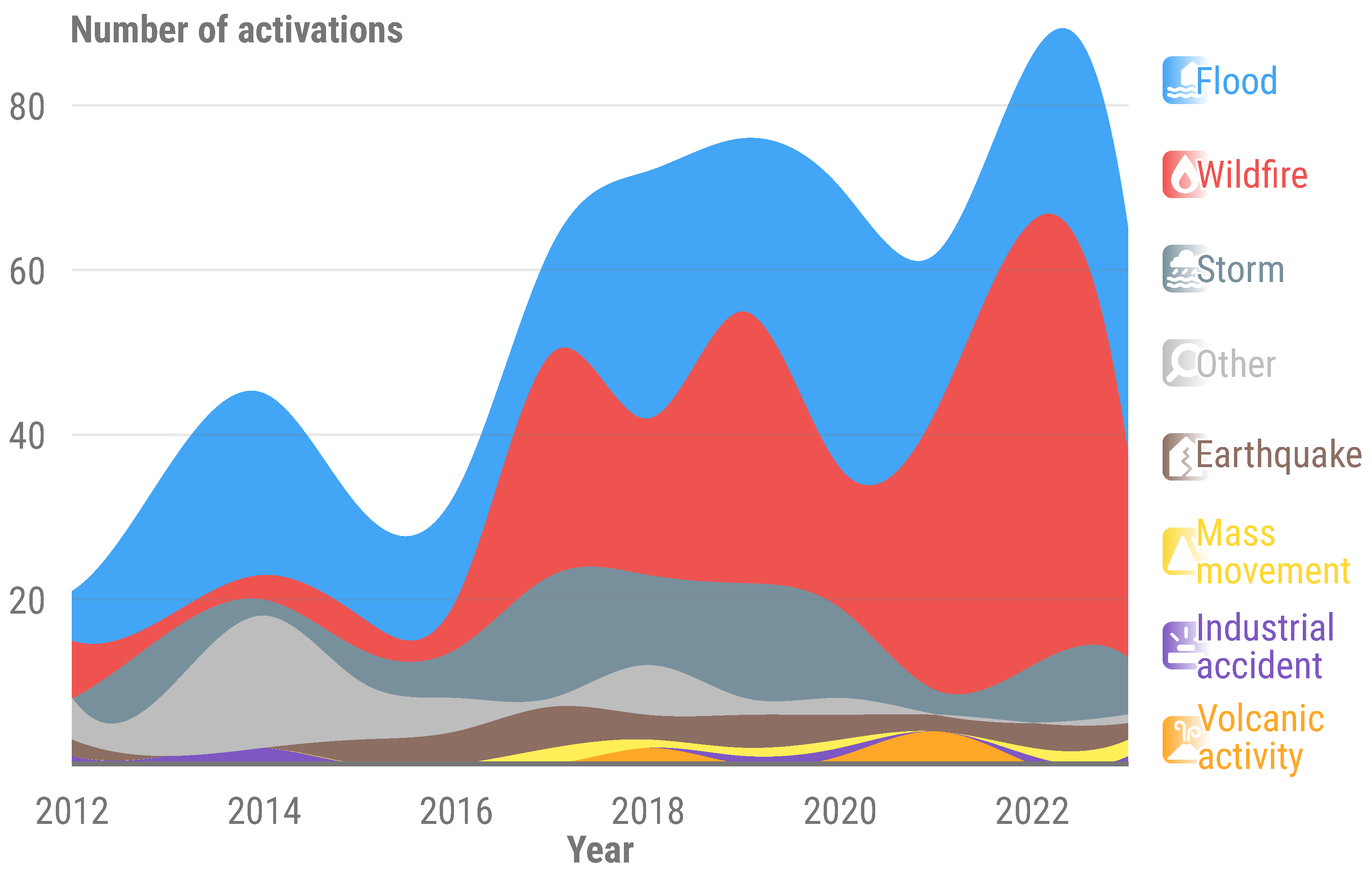

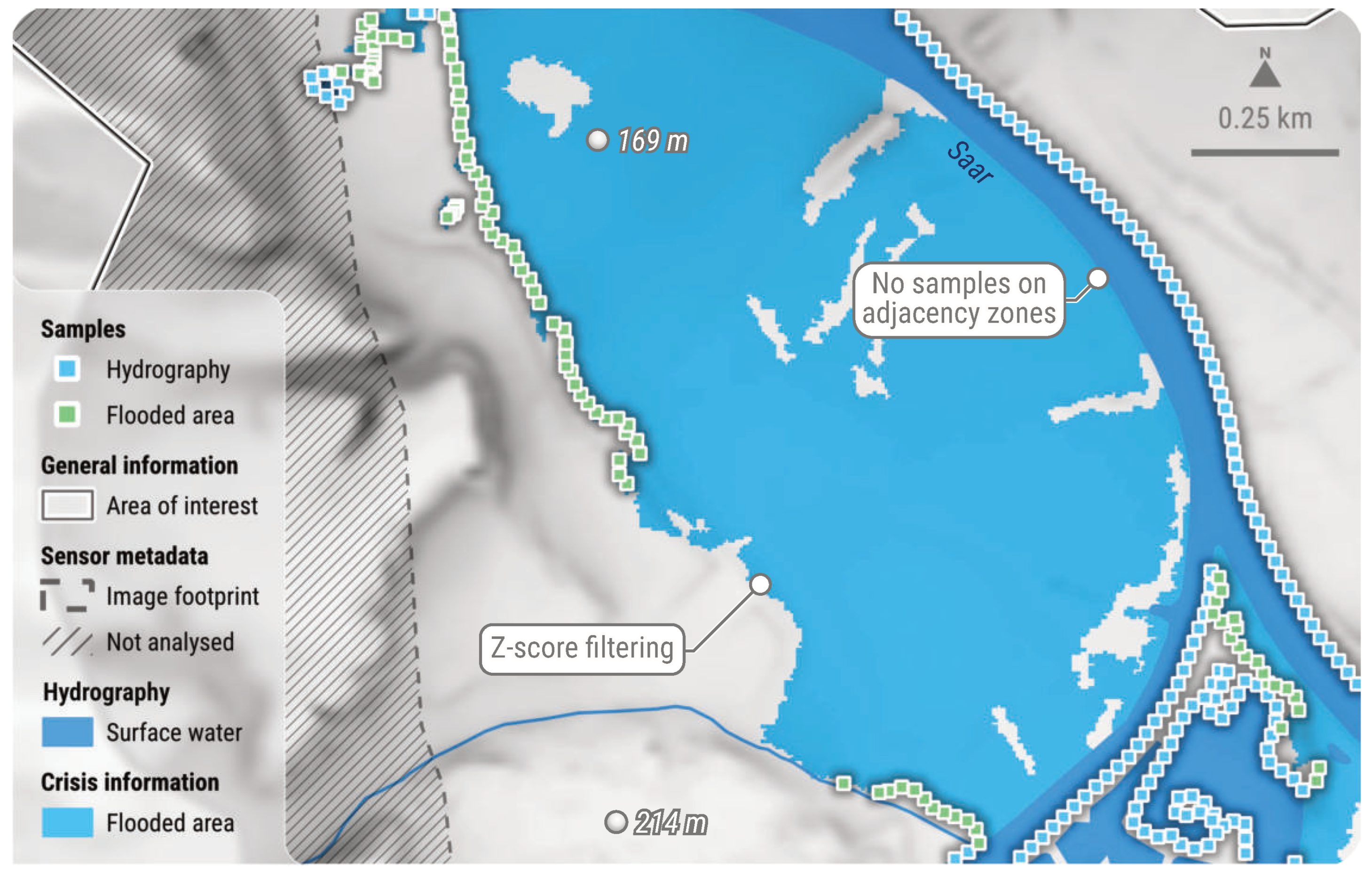


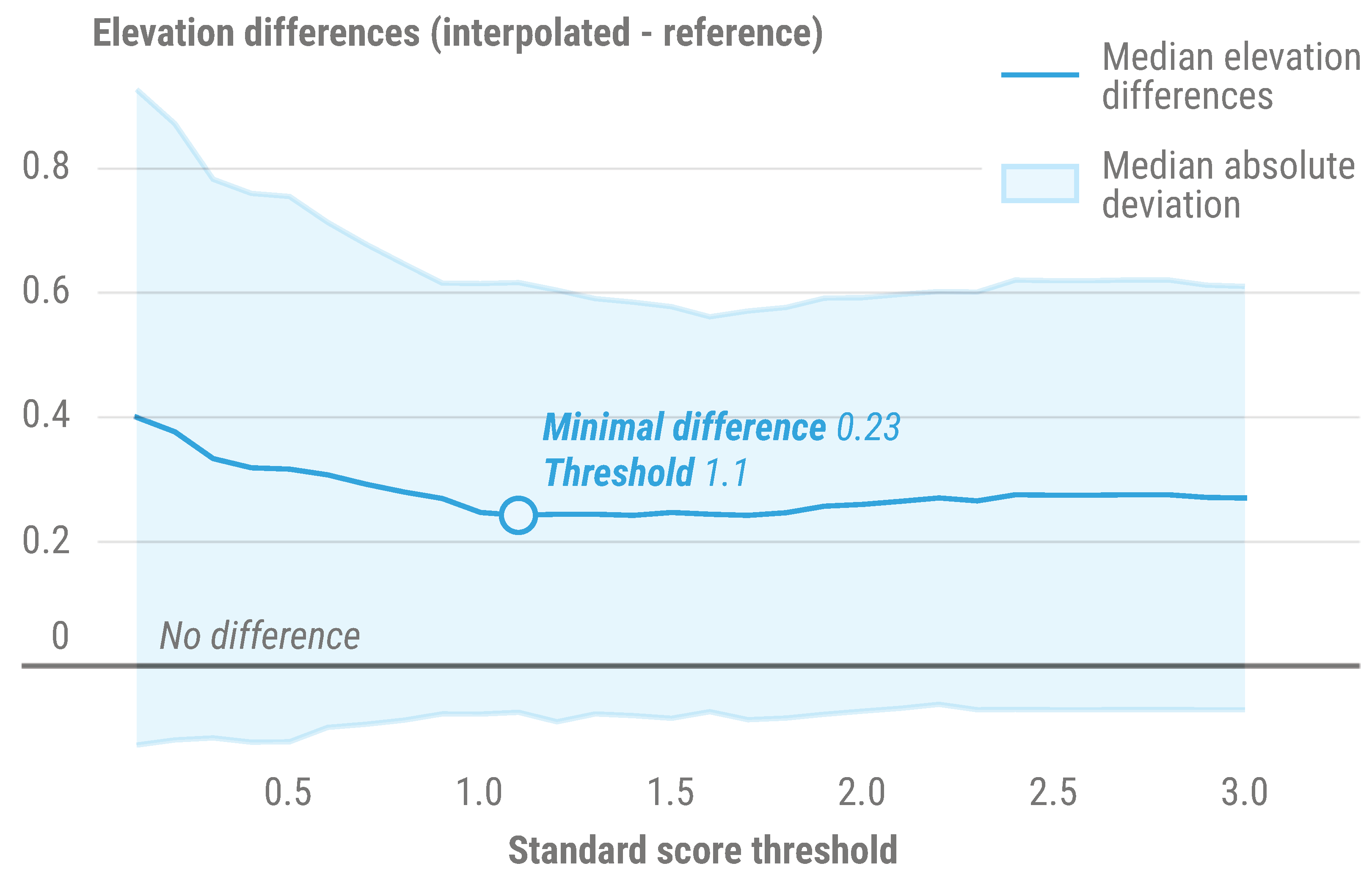

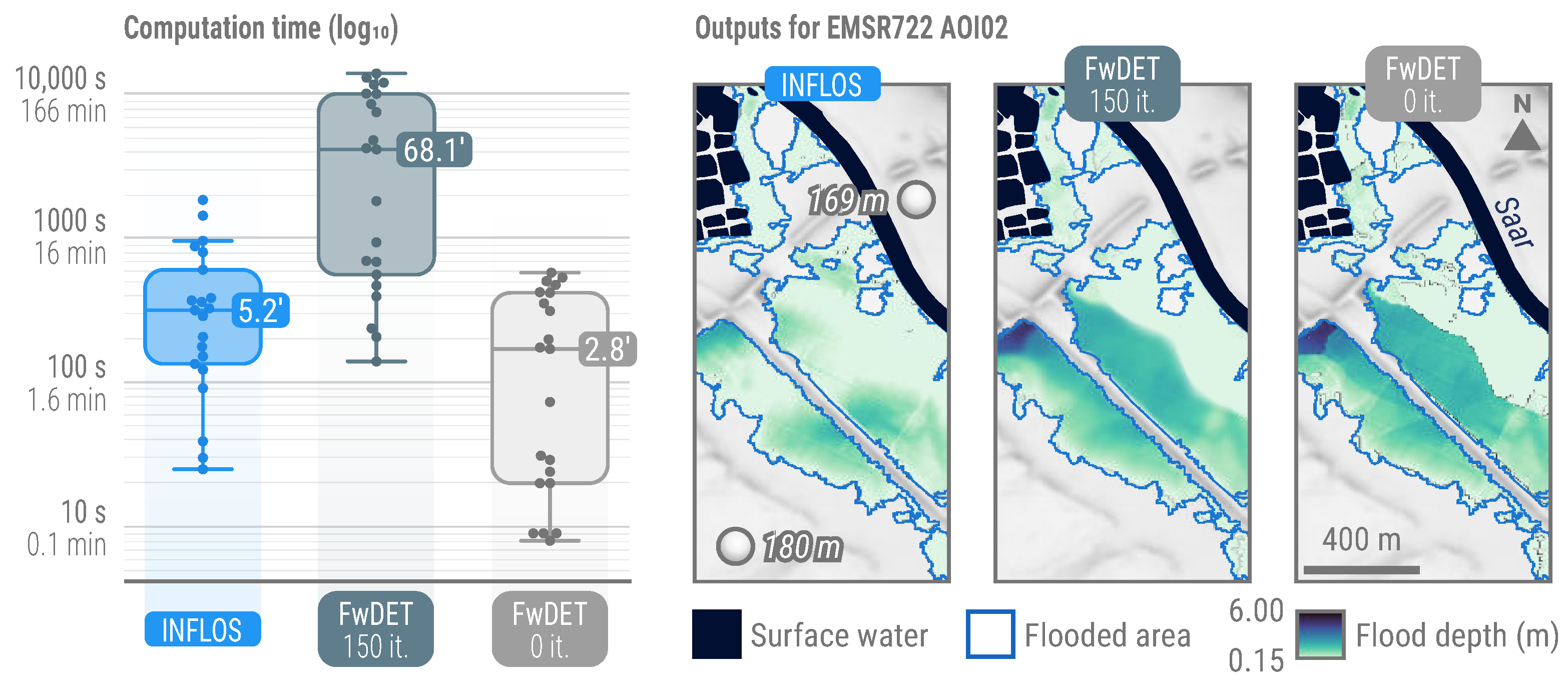
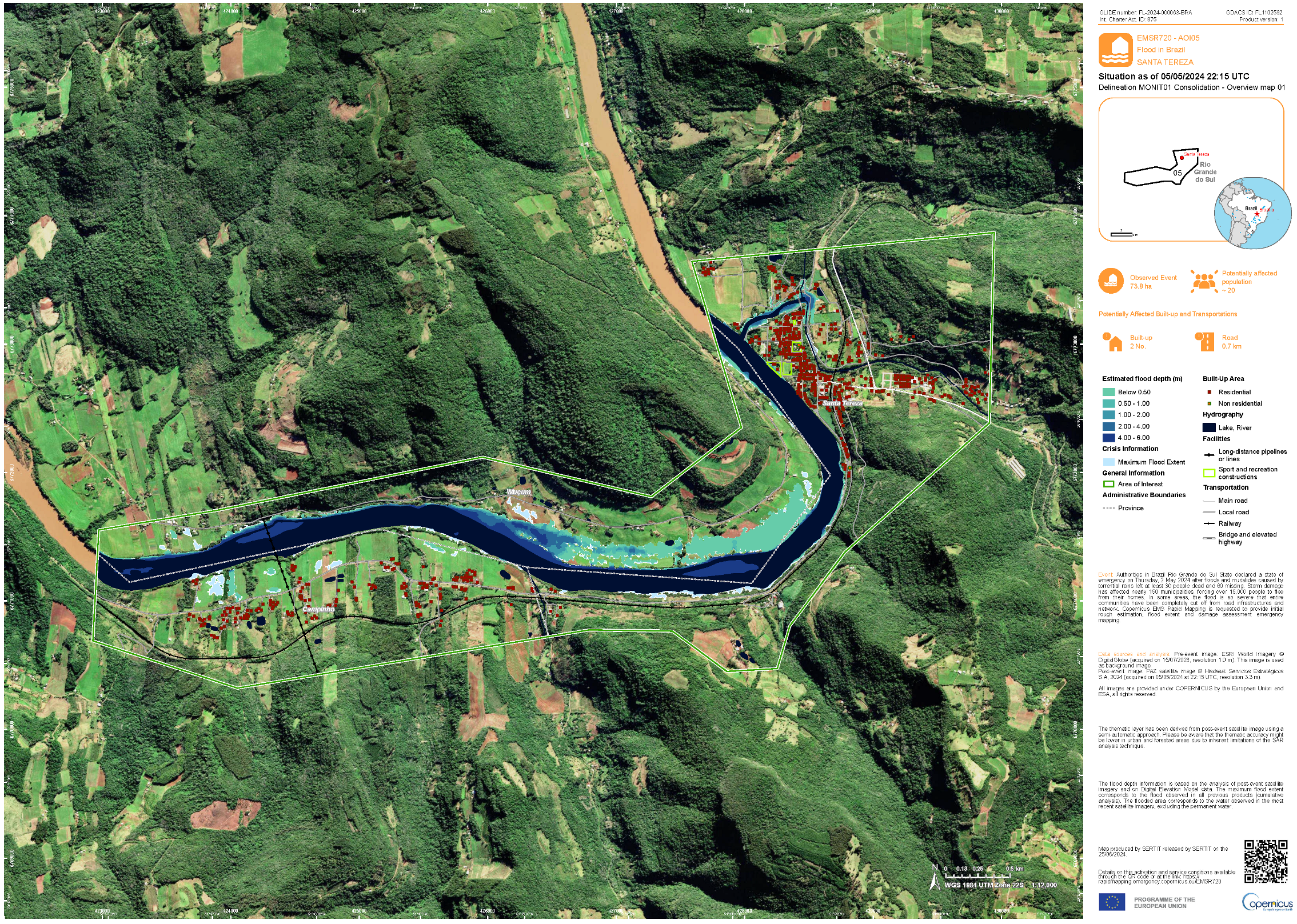

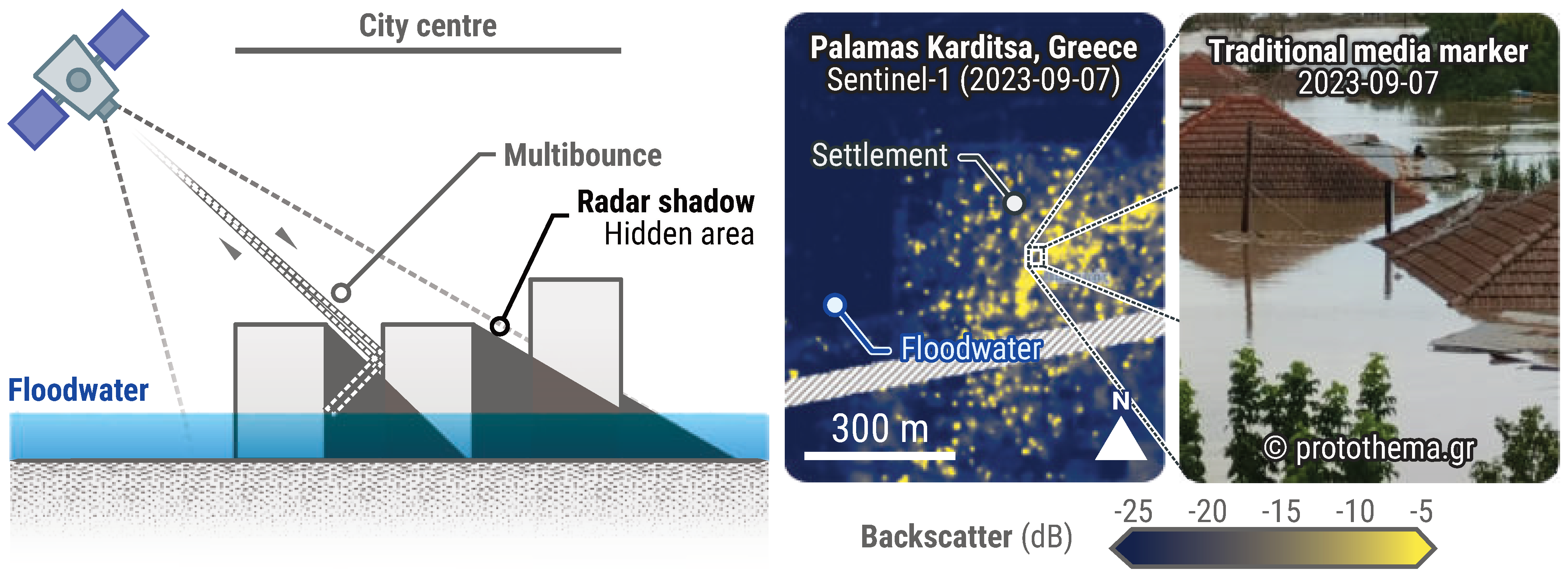
| Dataset | Acquisition | Comment |
|---|---|---|
| Elevation data | Downloaded from available sources (end-user, CORDA, FABDEM [31], etc.) | Highest available resolution |
| Hydrography | Downloaded from OpenStreetMap, digitised from reference imagery | Refinement might be necessary |
| AOI | Provided by the CEMS RM end-user | Should encompass the whole flooded domain |
| Not analysed areas | Derived from the AOI and crisis image footprint | Optional, to be provided when applicable |
| Flooded areas | Derived from crisis image | Should be of appropriate quality |
| Activation | Country and Region | No. AOIs | No. Products |
|---|---|---|---|
| EMSR692 |  Greece (Thessaly) Greece (Thessaly) | 7 | 28 |
| EMSR697 |  Greece (Thessaly, Sterea Ellada) Greece (Thessaly, Sterea Ellada) | 4 | 2 |
| EMSR698 |  United Kingdom (Scotland) United Kingdom (Scotland) | 3 | 5 |
| EMSR705 |  Italy (Tuscany) Italy (Tuscany) | 8 | 7 |
| EMSR706 |  France (Pas-de-Calais) France (Pas-de-Calais) | 7 | 15 |
| EMSR708 |  Belgium (Flanders) Belgium (Flanders) | 3 | 8 |
| EMSR711 |  France (Charente-Maritime) France (Charente-Maritime) | 3 | 4 |
| EMSR712 |  Germany (Lower Saxony) Germany (Lower Saxony) | 10 | 71 |
| EMSR713 |  Germany (Saarland) Germany (Saarland) | 1 | 1 |
| EMSR718 |  Ireland (Roscommon County) Ireland (Roscommon County) | 2 | 2 |
| EMSR720 |  Brazil (Rio Grande do Sul) Brazil (Rio Grande do Sul) | 5 | 7 |
| EMSR722 |  Germany (Saarland) Germany (Saarland) | 2 | 7 |
| EMSR725 |  Sweden (Norbotten County) Sweden (Norbotten County) | 4 | 3 |
| EMSR728 |  Germany (Bavaria, Baden-Württemberg, Hesse, Saxony, Saxony-Anhalt, Thuringia) Germany (Bavaria, Baden-Württemberg, Hesse, Saxony, Saxony-Anhalt, Thuringia) | 10 | 23 |
| 69 | 183 |
| Method | Pros | Cons |
|---|---|---|
| IDW |
| |
| Kriging | ||
| Natural neighbour |
|
|
| Activation | Locality | AOI | Event Size (ha) | Description |
|---|---|---|---|---|
| EMSR692 |  Greece Greece | 01 | 72,200 | Succession of flat and entrenched areas, major elevation amplitude, artefacts in DTM, multi-stage flooding, long monitoring. |
| EMSR698 |  United Kingdom United Kingdom | 01 | 2190 | Long and entrenched valley, major elevation amplitude, multi-stage flooding. |
| EMSR705 |  Italy Italy | 03 | 1635 | Flat landscape, artefacts in DTM. |
| EMSR706 |  France France | 04 | 700 | Flat landscape. |
| EMSR708 |  Belgium Belgium | 01 | 5300 | Flat landscape, coastal area. |
| Issue | DTM Used | Reference |
|---|---|---|
| Outdated product EMSR712  Germany GermanyLeft—10 m © GeoBasis-DE/BKG, 2018 Right—Sentinel-2, 10 m © Copernicus/ESA, 2023 |  | 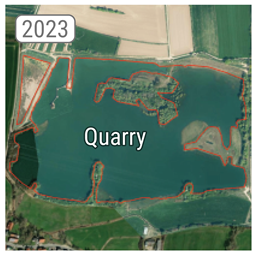 |
|
Product quality EMSR705  Italy ItalyLeft—10 m © Regione Toscana, 2023 Right—FABDEM, 30 m © Airbus, 2020 | 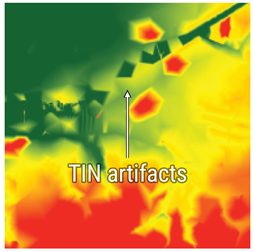 | 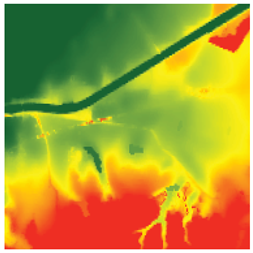 |
|
Confidential areas EMSR692  Greece GreeceLeft—5 m © Hellenic Cadastre, 2007–2009 Right—Not applicable © OpenStreetMap, 2025 | 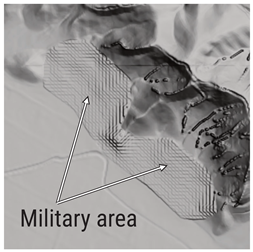 | 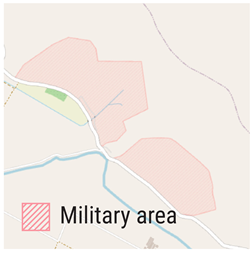 |
|
Compounding errors EMSR692  Greece GreeceLeft—5 m © Hellenic Cadastre, 2007–2009 Right—Sentinel-2, 10 m © Copernicus/ESA, 2023 | 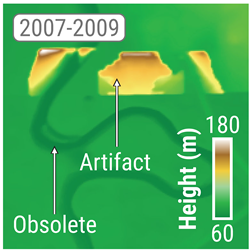 | 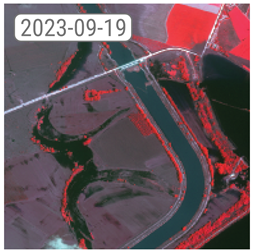 |
Disclaimer/Publisher’s Note: The statements, opinions and data contained in all publications are solely those of the individual author(s) and contributor(s) and not of MDPI and/or the editor(s). MDPI and/or the editor(s) disclaim responsibility for any injury to people or property resulting from any ideas, methods, instructions or products referred to in the content. |
© 2025 by the authors. Licensee MDPI, Basel, Switzerland. This article is an open access article distributed under the terms and conditions of the Creative Commons Attribution (CC BY) license (https://creativecommons.org/licenses/by/4.0/).
Share and Cite
Poterek, Q.; Caretto, A.; Braun, R.; Clandillon, S.; Huber, C.; Ceccato, P. INterpolated FLOod Surface (INFLOS), a Rapid and Operational Tool to Estimate Flood Depths from Earth Observation Data for Emergency Management. Remote Sens. 2025, 17, 329. https://doi.org/10.3390/rs17020329
Poterek Q, Caretto A, Braun R, Clandillon S, Huber C, Ceccato P. INterpolated FLOod Surface (INFLOS), a Rapid and Operational Tool to Estimate Flood Depths from Earth Observation Data for Emergency Management. Remote Sensing. 2025; 17(2):329. https://doi.org/10.3390/rs17020329
Chicago/Turabian StylePoterek, Quentin, Alessandro Caretto, Rémi Braun, Stephen Clandillon, Claire Huber, and Pietro Ceccato. 2025. "INterpolated FLOod Surface (INFLOS), a Rapid and Operational Tool to Estimate Flood Depths from Earth Observation Data for Emergency Management" Remote Sensing 17, no. 2: 329. https://doi.org/10.3390/rs17020329
APA StylePoterek, Q., Caretto, A., Braun, R., Clandillon, S., Huber, C., & Ceccato, P. (2025). INterpolated FLOod Surface (INFLOS), a Rapid and Operational Tool to Estimate Flood Depths from Earth Observation Data for Emergency Management. Remote Sensing, 17(2), 329. https://doi.org/10.3390/rs17020329








